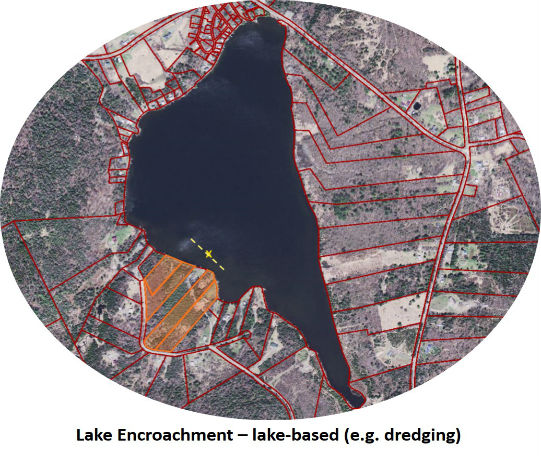***Important information regarding permit application submission***
You may now submit permit applications, compliance reports and fee payments through our new online form to expedite its receipt and review
Please use the forms below to fill out permit applications and submit the application and permit fees online through the link above. Please reach out to your regional Lake and Shoreland permitting contact with any questions.
During the review of a Lake Encroachment Permit application, the following factors are considered: the project's impact on water quality, fish and wildlife habitat, aquatic and shoreline vegetation, and navigation, recreation and other uses; the consistency with the natural surroundings; the consistency with local ordinances or state plans; and the cumulative impact of other existing encroachments. Applications are also reviewed for consistency with the Public Trust Doctrine. There must be a public purpose and/or public benefit associated with the project in order for the application to be approved. In making this public trust determination, consideration will be given to the public purpose served by the encroachment, the public benefits created by the proposed encroachment, and any adverse impacts on public trust uses and the public resource as a result of the encroachment.
The Watershed Management Division may conduct investigations, meetings, and site evaluations to verify information contained in an application. Generally it takes 60-90 days for a final decision to be issued once an application is considered complete.
Lake Encroachment Permit Application
Notice of Co-Permittee Status Form
Adjoining Property Owner Notification
As of January 1, 2018, the State of Vermont requires that all applicants applying for a Lake Encroachment Permit provide notice to adjoining landowners (10 V.S.A. § 7701 et seq).
As a part of submitting an administratively complete Lake Encroachment Individual Permit application, the applicant and/or their representative must provide notice to adjoining property owners at the same time the application is submitted. The applicant must certify on the application that notifying adjoining property owners has been completed prior to application submittal.
- If the project is considered large and complex, additional notification requirements apply. Contact an analyst for additional information. Use the Permit Navigator tool to identify the required environmental permits and approvals for projects on a single parcel. If it is a linear, polygon, or multi-parcel project, contact a Community Assistance Specialist to get started.
- The OFFICIAL NOTICE letter is required to be sent by U.S. Mail to notify an adjoining property owner. Permit application materials are not required to be sent with this notice.
- An Adjoining Property Owner Notice for each type of Lake Encroachment Permit application is required as follows:
|
Lake Encroachment Permits |
Adjoining Property Owners to be Notified |
|
Land-based projects (e.g. shoreline stabilization, boathouse repair, etc.) |
Adjoining property owners on the terrestrial boundaries of the shoreline from which the project originates. Notice is not required for property owners across the lake. |
|
Lake-based projects proposed to be located in or extending beyond 50 feet from a point along the shoreline as delineated by the mean water level (e.g. dredging, marina expansions, etc.) |
Any property owners that may potentially be affected by a decision on the application, including but not limited to the terrestrial boundaries nearest to the proposed project. |


Lake Encroachment Permit Fees
Amendments to a Lake Encroachment Permit
If you are proposing to change a project authorized under a Lake Encroachment Permit, you may require a Lake Encroachment Permit Amendment. To submit an amendment to an existing Lake Encroachment Permit, use the Lake Encroachment Application and indicate that the proposed project is an amendment. Depending on the proposed changes to the project, the amendment may be considered a major amendment or a minor amendment. Both types of amendments are posted to the Environmental Notice Bulletin. Please contact your regional permit analyst to determine whether your proposed Lake Encroachment Permit Amendment would be considered major or minor.
A Major Permit Amendment means that the proposed changes to an individual permit require the regional permit analyst to complete technical review. A major permit amendment requires adjoining property owners be notified of the proposed amendment. The draft decision for a proposed major amendment will be placed on public notice for a minimum of 30 days. Examples of major amendments include:
- An expansion of a previously authorized encroachment
- A relocation of a previously authorized encroachment
A Minor Permit Amendment means that the proposed changes to an individual permit condition or requirement does not necessitate technical review. A minor permit amendment does not require adjoining property owners be notified of the proposed amendment. The draft decision for a proposed minor amendment will be placed on public notice for a minimum of 14 days. Examples of minor amendments include:
- A modification to the project as shown on the Approved Application that is within the scope of the permit.
- A change to a non-technical detail; clarification of the project description; or a change of wording to the original permit that does not necessitate technical review
